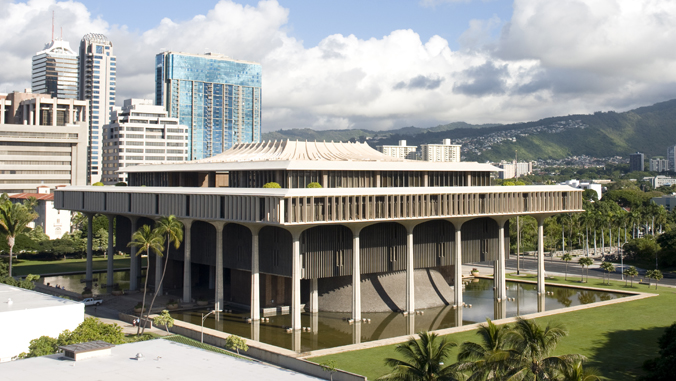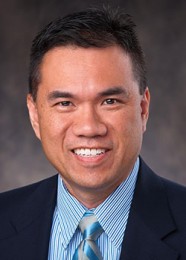

Kalbert Young, UH vice president for budget and finance and chief financial officer, shares his analysis of the Hawaiʻi State Legislature 2021 session.
The 2021 Legislature adjourned on April 29, after passing more than 260 bills, which the governor will now consider for enactment. Some of these bills will impact the University of Hawaiʻi either directly or indirectly.
This was the first year of the Legislature’s biennium (two-year cycle). Since lingering tax revenue impacts from the ongoing COVID-19 pandemic are still a major factor on the state budget, and federal stimulus aid has recently been enacted to help the state, the budget bill was arguably the most significant measure of the session. The following will highlight components of the budget as it relates to UH and identify some possible funding impacts to our campuses. In addition to the budget overview, I will also highlight a few other significant measures that passed the Legislature this session.
Operating budget
HB 200 CD1, the biennium budget bill, passed the Legislature and has been transmitted to the governor for his consideration. The table below compares the UH items funded by the legislature and what was requested by the Board of Regents.
| Campus | Description | ||||
|---|---|---|---|---|---|
| Board | CD1 | ||||
| FY22 | FY23 | FY22 | FY23 | ||
| UH Mānoa | UH Mānoa Athletics | $3,600,000 | $3,600,000 | ||
| UH Hilo | UH Hilo Athletics | $400,000 | $400,000 | ||
| UH Community Colleges | Hawaiʻi Promise Program | $700,000 | $700,000 | ||
| UH Mānoa | Add (3) Positions and Funds for HIMB | $197,228 | $197,228 | ||
| UH Mānoa | Reduce (1) filled position and funds | ($343,800) | ($343,800) | ||
| UH Hilo | Add Funds for Athletics | $105,895 | |||
| UH Mānoa | Transfer funds to new UH Cancer Center Program ID | ($3,098,055) | ($3,098,055) | ||
| UH Cancer Center (new) | Transfer-in from UH Mānoa | $3,098,055 | $3,098,055 | ||
| UH West Oʻahu | Add (2) Positions and Funds | $164,394 | $164,394 | ||
| UH Community Colleges | Add (3) Positions and Funds | $160,000 | $220,000 | ||
| UH Mānoa | Reduce Funds | ($35,600,000) | ($30,000,000) | ||
| JABSOM | Reduce Funds | ($1,200,000) | ($1,200,000) | ||
| UH Hilo | Reduce Funds | ($2,280,000) | ($2,280,000) | ||
| UH West Oʻahu | Reduce Funds | ($1,080,000) | ($1,080,000) | ||
| UH Community Colleges | Reduce Funds | ($4,600,000) | ($4,600,000) | ||
| UH Systemwide Support | Reduce Funds | ($3,391,232) | ($3,391,232) | ||
| Total | $4,700,000 | $4,700,000 | ($47,867,515) | ($42,313,410) | |
American Rescue Plan Act Add-ons
| Campus | Description | ||||
|---|---|---|---|---|---|
| Board | CD1 | ||||
| FY22 | FY23 | FY22 | FY23 | ||
| UH Mānoa | Add Funds for UHERO | $1,200,000 | |||
| Aquarium | Add Funds for Waikīkī Aquarium | $1,000,000 | |||
| UH Community Colleges | Add Funds for Hawaiʻi Promise | $1,300,000 | $1,300,000 | ||
It is important to note that the Board of Regents budget request for $4.7 million per year was not for new funding, but to continue funding for currently operating programs at the university—notably support for athletics programs at UH Mānoa and UH Hilo and funding for the Hawaiʻi Promise Program at the community colleges.
Instead of providing general fund additions, the Legislature reduced UH’s general fund budget by $47.9 million in the first year of the biennium and $42.3 million in the second year. (It should be noted that the Hawaiʻi Promise Program did receive support from federal funds appropriated to the state.) To put this reduction in perspective, these cuts are nearly 10% of UH’s general fund appropriations of approximately $500 million annually. At the start of 2021, all state departments were anticipating that funding was going to be a challenge. Some of that sentiment eased during the legislative session with the emergence of significant federal stimulus aid to the state. However, the end product of the budget passed by the Legislature does not reflect a balanced or thoughtful approach to the overall UH budget.
As is clearly evident, the budget passed by the Legislature demonstrates an approach that disproportionately reduces funding to the university. UH Mānoa, by far, is the most severely impacted in the budget since it will have the largest amount of general funding reduction (-$35.6 million in FY22), as well as the largest percentage reduction than any other campus—approximately -13.8% of their current budget. A relative comparison of all campuses within the UH system shows that the UH Mānoa general fund appropriation is approximately $210 million, or 42% of the total UH general fund budget, while their $35 million reduction represents 74% of the total cut to UH.
The Legislature provided federal American Rescue Plan Act (ARPA) funding to three specific areas for a total of $3.5 million in FY22 and $1.3 million in FY23. However, $1.3 million in ARPA funding is to replace reductions of general funds for the Hawaiʻi Promise Program. Not included in the legislatively-appropriated budget are Higher Education Emergency Relief Funds (HEERF) included as part of the three federal coronavirus response packages, and granted as federal assistance to campuses and student aid. Some HEERF monies may have to be reallocated to supplant general fund reductions.
Capital improvement projects
HB 200 CD1 provided a moderate funding level for the UH System to address capital improvement projects and deferred maintenance, which has been consistently a major historical area of concern for the university. The Legislature appropriated $230.4 million in FY22 and $102.6 million in FY23 in general obligation bonds for the following projects:
| Campus | Project Title | ||||
|---|---|---|---|---|---|
| Board | CD1 | ||||
| FY22 | FY23 | FY22 | FY23 | ||
| UH System | Renew, Improve and Modernize | $110,500,000 | $110,500,000 | $51,800,000 | $47,640,000 |
| UH Community Colleges | Capital Renewal and Deferred Maintenance | $25,000,000 | $25,000,000 | $25,000,000 | |
| UH Community Colleges | Minor CIP | $25,000,000 | $25,000,000 | $15,000,000 | $20,000,000 |
| UH Hilo | Renew, Improve and Modernize | $24,000,000 | $13,500,000 | $1,300,000 | |
| UH Mānoa | Mānoa Mini Master Plan Phase 2 | $60,000,000 | $35,000,000 | $35,000,000 | |
| UH Community Colleges | Honolulu CC Technology Renovations | $15,000,000 | $15,000,000 | ||
| Aquaria | Waikīkī Aquarium | $1,500,000 | $9,000,000 | $1,500,000 | |
| UH Community Colleges | ADA Upgrades | $14,000,000 | $14,000,000 | ||
| UH West Oʻahu | Renew, Improve and Modernize | $3,000,000 | $3,000,000 | $3,500,000 | |
| UH Community Colleges | Windward CC Agripharmatech Bioprocessing Facility | $3,000,000 | $3,000,000 | ||
| UH Mānoa | Central Admin Facility with Parking | $4,000,000 | |||
| UH West Oʻahu | Planning Projects | $500,000 | $500,000 | ||
| UH Community Colleges | Kapiʻolani CC–Kokiʻo | $2,500,000 | $30,000,000 | ||
| UH Community Colleges | UH Maui College Vocational Tech | $2,000,000 | |||
| UH Mānoa | CTAHR–Waialeʻe Research Station | $1,600,000 | |||
| UH Hilo | Maunakea Telescope Removal (Hōkū Keʻa) | $900,000 | |||
| UH Community Colleges | Resource and Education Center | $42,500,000 | |||
| UH System | Makai Research Pier | $5,550,000 | |||
| UH Mānoa | Lyon Arboretum | $1,200,000 | |||
| UH Community Colleges | Proof of Concept for Maui Health System | $500,000 | |||
| Total | $288,000,000 | $232,500,000 | $203,350,000 | $102,640,000 | |
Additional projects—either not General Obligation Bonds or not in UH
| Campus | Project Title | ||||
|---|---|---|---|---|---|
| Board | CD1 | ||||
| FY22 | FY23 | FY22 | FY23 | ||
| UH Hilo | Renew, Improve and Modernize (American Rescue Plan Act Funds) | $8,700,000 | |||
| Warehouses for Dept. of Agriculture | $28,000,000 | ||||
Overall, the amount of capital funding support in the budget is decent and appreciation can be extended to the Legislature for its level of support. The funding should help to address some of the capital needs across the UH System. The amount of work left is still substantial, and the level of funding is still short of addressing immediate reduction of UH’s deferred maintenance backlog.
While we can be appreciative of the level of funding provided, there were also a few projects that were not requested by UH, yet they were put into the university’s budget. For example, $42.5 million has been provided to construct a Resource and Education Center, which was not requested by the Board, and it is unclear what this project entails. Additionally, $28.0 million was appropriated by the Legislature to the Department of Agriculture, but UH is the “expending agency” for these funds. Again, it is unclear what the purpose of this project is or how it relates to UH. It is unclear as to the extent that these funding choices of the Legislature came at the expense of funding other actually needed UH priorities.
UH legislative package
As mentioned in my last update, UH submitted a number of bills for consideration this session. Others arose within the Legislature itself. Several consequential measures did pass the Legislature, although in a rather complicated and convoluted form.
SB589 CD1 went through many variations before the final product was passed by the Legislature. In the end, there are five parts to this bill:
- Part I establishes the UH Cancer Center in statute and requires the UH Cancer Center to be administratively affiliated with the John A. Burns School of Medicine (JABSOM). It also treats the UH Cancer Center and JABSOM differently than every other unit at UH by restricting their use of Tuition and Fees Special Funds to educational purposes only.
- Part II requires UH to develop a plan for JABSOM and the UH Cancer Center to achieve greater operational efficiencies.
- Part III extends the sunset for the technology transfer and commercialization of university intellectual properties.
- Part IV extends the sunset for UH’s innovation and commercialization initiative program.
- Part V extends the sunset date for UH’s president to act as UH’s chief procurement officer in lieu of the State Procurement Office.
While Parts III, IV and V help the university with its missions of growing the state’s economy through innovation and reducing UH’s backlog of deferred maintenance, Parts I and II do nothing to assist the university and the restrictions on the use of UH’s funds may also be problematic. Although these initiatives were in separate bills at the beginning of the legislative session, they are now in one “omnibus” measure.
Another section of SB589 CD1 adds provisions imposing new and quite burdensome requirements on the university’s innovation efforts to partner with employees to commercialize intellectual property and research activities, as is commonly done at peer R1 institutions throughout the country. These provisions were not heard in either chamber of the Legislature and only appeared at the last minute during the conference phase of the Legislative Session when no public testimony is taken. These provisions also do not account for existing contracts already entered into. As the university tries to create additional sources of revenue to reduce its need for general funds, this type of disruption seems at best, counterproductive.
There are similar components in other bills that will have some impact on our university. While many are innocuous, some are impactful, and a few will have significant ramifications if they take effect as written. The UH administration is now reviewing all bills from multiple perspectives and assessing the go-forward options and impacts on the university. The governor has until July 6, 2021, to either sign, veto or allow bills to become law without his signature.

